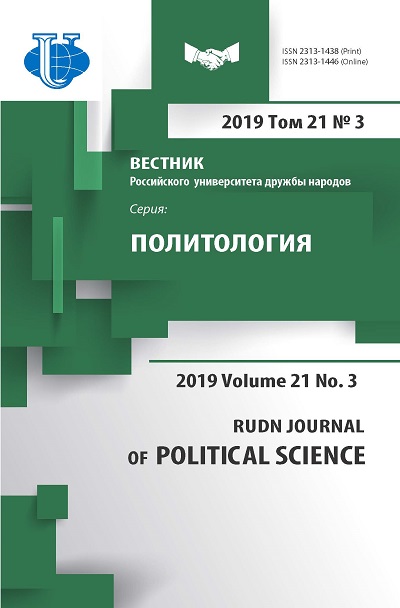Использование интернет-технологий для мобилизации электората: особенности, субъекты и перспективы
- Авторы: Антонов Д.Е.1
-
Учреждения:
- Московский государственный университет имени М.В. Ломоносова
- Выпуск: Том 21, № 3 (2019)
- Страницы: 538-548
- Раздел: АКТУАЛЬНЫЕ ВОПРОСЫ ПОЛИТИЧЕСКОЙ НАУКИ
- URL: https://medbiosci.ru/2313-1438/article/view/339721
- DOI: https://doi.org/10.22363/2313-1438-2019-21-3-538-548
- ID: 339721
Цитировать
Полный текст
Аннотация
В статье анализируется роль интернет-технологий в процессе мобилизации электората. Одним из последствий реформ, проводимых в России, станет медиатизация избирательного процесса. Современные подходы к пониманию электоральной мобилизации основаны на классических элитистских концепциях и теории массового общества. Подобный ракурс не позволяет выявить отдельных субъектов мобилизационного воздействия и проанализировать их собственные стратегии. Автор предлагает взглянуть на проблему с позиций неоинституционального подхода. Мобилизационное воздействие может трактоваться как форма субъект-объектных интеракций разных субъектов избирательного процесса. Автор выделяет три основные цели мобилизационных интеракций: привлечение новых сторонников, побуждение к конкретной форме политической активности, а также выбору определенной позиции в избирательном бюллетене. Второй задачей автора является оценка особенностей использования интернет-технологий в процессе электоральной мобилизации. В заключении статьи указываются возможные тенденции развития технологий интернет-мобилизации электората. Выбранный ракурс исследования позволяет сделать выводы о том, какие формы приобретет работа с избирателями в условиях развития технологий интернет-коммуникаций.
Ключевые слова
Об авторах
Дмитрий Евгеньевич Антонов
Московский государственный университет имени М.В. Ломоносова
Автор, ответственный за переписку.
Email: a.dmitry.msu@gmail.com
ассистент кафедры истории и теории политики факультета политологии
Москва, РоссияСписок литературы
- Background to “Assessing Russian Activities and Intentions in Recent US Elections”: The Analytic Process and Cyber Incident Attribution. Analytical report. Office of the Director of National Intelligence. 06.01.2017. Available from: dni.gov/files/documents/ICA_2017_01.pdf. Accessed: 09.03.19.
- Volodenkov S. The Total Data as the Phenomenon of Formation of Political Postreality. Bulletin of Omsk University. Series “Historical Sciences”. 2017; 3: 409—415 (In Russ.).
- Irkhin I. Elections of the 45th President of the USA: Key Features, Techniques, Results. Ars ADMINISTRANDI. 2017; 1: 111—131 (In Russ.).
- Easton D. Categories of System Analysis of Policy. Political Science: reader. Comp. by M.A. Vasilik, M.S. Vershinin. Moscow: Gardariki; 2000: 319—331 (In Russ.).
- Castels M. The Power of Communication. Moscow: Higher school of Economics; 2016. 564 p. (In Russ.).
- Communicative Technologies in the Processes of Political Mobilization. Eds. V. Achkasova, G. Melnik. Moscow: FLINTA: Science; 2016. 248 p. (In Russ.).
- Meyer T. Media Democracy. How the Media Colonize Politics. Oxford: Polity; 2002. 184 p.
- Nesmashny A. Internet-technologies in Politics and Political Information Internet-technologies: Differences in Essence and Content of the Notions. Society and Authority. 2017; (2): 59—64. doi: 10.22394/1996-0522-2017-2-59-64 (In Russ.).
- Program “Digital Economy of the Russian Federation”. Available from: static.government.ru/ media/files/9gFM4FHj4PsB79I5v7yLVuPgu4bvR7M0.pdf. Accessed: 09.03.2019 (In Russ.).
- Way L.C., Casey A. Russian Foreign Election Interventions Since 1991. PONARS Eurasia Policy Memo No. 520. March 2018. Available from: ponarseurasia.org/sites/default/files/policy-memos-pdf/Pepm520_Way-Casey_March2018.pdf. Accessed: 09.03.2019.
- Safronov A. Radical Populism and Mobilization Participation. Moscow: KomBook; 2006. 245 p. (In Russ.).
- Svinin A. Social Networks as Internet-technologies in Electoral Campaigns: International View. RUDN Journal of Political Science. 2013; 2: 157—163 (In Russ.).
- Special Report on the Results of the Presidential Election in the Russian Federation (2018) in Terms of Violations of Russian Electoral Sovereignty. 2018. 46 p. Available from: council.gov.ru/media/files/2uQuCAAwoWu0B8tiDeDExn5x9CtBkTDV.pdf. Accessed: 09.03.2019 (In Russ.).
- AmoCRM. Available from: amocrm.ru. Accessed: 09.03.2019.
- Bennett W.L., Manheim J.B. The One-step Flow of Communication. The Annals of the American Academy of Political and Social Science. 2006; Vol. 608; 1: 213—232.
- Bitrix24. Available from: bitrix24.ru/features/index.php. Accessed: 09.03.2019.
- Bond R., Fariss C., Jones J., Kramer A., Marlow C., Settle J., Fowler J. A 61-Million-Person Experiment in Social Influence and Political Mobilization. Nature. 2012; 489: 295—298.
- Herman E., Chomsky N. Manufacturing Consent: The Political Economy of the Mass Media. N.Y.: Pantheon books; 2002. 407 p.
- Innis H. The Bias of Communication. Toronto: University of Toronto Press; 2008. 226 p.
- Kwon K.H., Stefanone M.A., Barnett G.A. Social Network Influence on Online Behavioral Choices: Exploring Group Formation on Social Network Sites. American Behavioral Scientist. 2014; Vol. 58; 10: 1345—1360.
- Meyer T. Media Democracy. How the Media Colonize Politics. Oxford: Polity; 2002. 184 p.
- NationBuilder. Available from: nationbuilder.com. Accessed: 09.03.2019.
- Polis. Available from: polisinc.com. Accessed: 09.03.2019.
- Rosenau J.N. Turbulence in World Politics: A Theory of Change and Continuity. Princeton: Princeton University Press; 1990. 480 p.
- Thompson J.B. Media and Modernity: A Social Theory of Media. Cambridge; 1995. 328 p.
Дополнительные файлы








